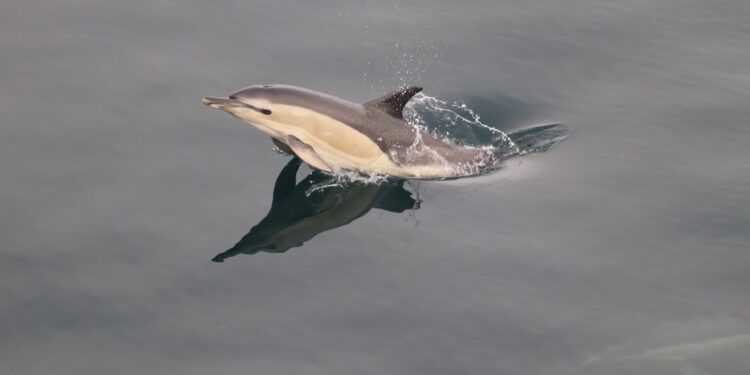The common dolphin is the most abundant cetacean in the world. Credit: Pélagis Observatory, France
Common dolphins are among the most abundant mammals in the ocean, but they live shorter lives in the North Atlantic, according to a new study published in Conservation letters.
The research team, led by the University of Colorado Boulder, found that the longevity of female common dolphins has declined by seven years since 1997, an alarming trend that the authors say threatens not only the species but also the marine ecosystem it helps maintain.
“There is an urgent need to better manage the population,” said Etienne Rouby, a postdoctoral researcher at the Institute for Arctic and Alpine Research (INSTAAR). “Otherwise there is a risk of decline and, ultimately, extinction.”
Around 6 million common dolphins roam tropical and temperate oceans around the world. They are the most common cetaceans in the world, a group that includes all whales, dolphins and porpoises.
The Bay of Biscay in the Atlantic Ocean, off the coast of France, is a popular destination for dolphins in winter because its warmer, nutrient-rich waters attract smaller fish species like anchovies and sardines that the dolphins prey on. But these same conditions also make it one of the hotspots for fishing in Europe.
Although dolphins are not the target of fishing, many of them end up in nets by accident, also called “bycatch.” Most dolphins caught accidentally die. Some studies estimate that in 2021, fishing bycatch was responsible for the deaths of 6,900 dolphins in the bay, out of a winter population of 180,000 individuals.
Despite these figures, traditional methods of monitoring abundance previously suggested that the dolphin population in the bay was stable.
Traditionally, scientists estimate dolphin numbers by counting individuals spotted by survey ships and planes. Since dolphins are constantly moving in and out of a region, this approach can ignore population changes until drastic changes occur.
For long-lived animals that produce only a few young over their lifetime, such as dolphins, recovery may not be possible once the population decline is large enough to show up in general counts, Rouby said.
He and his team set out to reassess the survival of these cetaceans using a new approach they developed: counting and analyzing deceased dolphins washed up on the bay’s beaches.
Dolphins often come to shore because they are old, sick, injured or disoriented, and few survive after becoming stranded. While stranded dolphins only account for about 10% of total dolphin deaths, changes in their mortality patterns over time can reveal broader population trends.
The team studied 759 common dolphins stranded on the beaches of the Bay of Biscay between 1997 and 2019.
“We wanted to capture changes in population survival and fertility rates. These are more sensitive indicators of population health, and they allow us to identify problems before they become irreversible,” he said.
By analyzing the dolphins’ teeth, the team determined the age at which these animals died. The team found that the longevity of female dolphins had declined, from 24 years in the late 1990s to just 17 years two decades later. This decline has led to a decrease in the number of births, the study suggests.
Researchers estimated that the growth rate of the dolphin population declined by 2.4% between 1997 and 2019. Under ideal conditions, a healthy common dolphin population ideally grows by about 4% per year. This means that while the population was thriving perfectly in 1997, it was only growing 1.6% per year in 2019.
“The numbers are probably lower in reality,” Rouby said. If the trend continues, the growth rate could fall below zero, a threshold that would signal a population decline, he added.
Since 2024, the French government has closed the Bay of Biscay to fishing for a month each January to protect dolphins. Although some data suggests the measure has been helpful, Rouby said a more flexible schedule might work better.
Depending on ocean conditions, dolphins may arrive in the bay earlier or later than the designated period in January, so timing fishing restrictions around dolphin visits would better protect the animals.
Other North Atlantic cetaceans, including the harbor porpoise and bottlenose dolphin, may also experience similar declines. Studying the health of their populations could improve current conservation policies, including the U.S. Marine Mammal Protection Act and the European Marine Strategy Framework Directive, Rouby said.
“Dolphins are the main predators in the Bay of Biscay and they play a very important role in the ecosystem. Without these predators, fish populations could get out of control and would in turn consume too much plankton and vegetation until the system collapses,” Rouby said.
“As humans, we must make conscious decisions to protect the living and non-living things around us. Faced with evidence of loss of viability, we must act before it is too late.”
More information:
Etienne Rouby et al, Collapse of longevity in dolphins: a growing concern for conservation in the Bay of Biscay, Conservation letters (2025). DOI: 10.1111/conl.13142
Provided by University of Colorado Boulder
Quote: Study finds decline in North Atlantic dolphin lifespan and population growth (October 15, 2025) retrieved October 15, 2025 from
This document is subject to copyright. Except for fair use for private study or research purposes, no part may be reproduced without written permission. The content is provided for informational purposes only.


